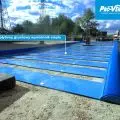Work submitted for the competition
"Best Diploma Architecture"
The aim of the work is to outline the strategy of reuse in architecture as a key step in reducing the negative impact of construction on the environment. The project introduces the idea of circular economy using the example of the adaptation of a complex of office buildings for residential purposes.
Eurostat data shows that as much as 1/3 of solid waste in Europe comes from construction and demolition. In addition, these processes generate 11 percent of greenhouse gas emissions. Reducing emissions and consumption of non-renewable raw materials is a key design challenge of the 21st century. The theory of the three R's — reduce, reuse, recycle — sets the sequence of actions to achieve climate goals. Under conditions of global housing demand and rapidly growing cities, reuse is the most feasible strategy for achieving them.
existing structure
© Michal Deja
The primary reason for demolition is the disconnect between the dynamically changing needs of people and the static and permanent response provided by architecture. As a counterpoint, the circular design paradigm treats a building not as a material artifact, but as a set of functions responding to current social needs. As an intangible, an object is merely a stop along the path of building components that can be reused to the limit of the life of their materials. The decoupling of matter and its current use makes continuous adaptation not an end in itself, but a by-product of the circular management of architecture.
axonometries, demolitions and design
© Michal Deja
For the application of the circular design strategy, the author chose a complex of abandoned office buildings from the 1980s located in Milan. A local developer has taken on the task of adapting the buildings to a residential function, pushing back the risk of demolition. The situation is an ideal reason for realizing a reuse scenario taking into account the building's future life cycle.
plans
© Michal Deja
The design strategy is based on maximizing the use of the existing structure, using elements from nearby demolitions and designing the new elements to facilitate their dismantling and future use. In particular, using the existing structure will save nearly 10,000 cubic meters of reinforced concrete. To offset the associated carbon dioxide, it would take the work of 1,500 trees over a period of 100 years. Architecturally, the problem of converting an office building into apartments has been solved by introducing new communication to allow access to the apartments in three typologies: caged, gallery and terraced; reducing the depth of the tract in favor of galleries, traditional for Milan; and introducing semi-private outdoor space in the form of balconies and conservatories on the galleries.
visualization
© Michal Deja
The distinctive staircases in the form of reinforced concrete towers, reminiscent of late Brutalism, have been retained, highlighting the role of adaptation in giving buildings an individual style that allows residents to identify with their place of residence.
One of the existing pavilions was converted into a supermarket; it powers a heat pump that heats the apartments. The other was partially demolished, and its columns were used to create flowerbeds where residents will be able to plant plants. More common spaces were proposed on the first floor, green roofs and covered terraces.
visualization
© Michal Deja
The result of the design efforts is an estate that will not only provide a high quality of life now, but will allow the environment to be preserved in a state that will allow it in the future.
Michal DEJA
Illustrations: © Author






































